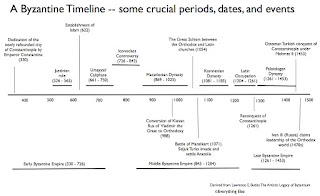On Saturday, April 7, I traveled to the Smithsonian in Washington, DC, to attend a day-long lecture series titled The Artistic Legacy of Byzantium. The event was organized by the Smithsonian Associates and the Lecturer was Dr. Lawrence E. Butler, Associate Professor of Art History, George Mason University.
The program was divided into four separate lectures:
- Building Constantinople
- The Byzantine Icon
- Luxury Arts
- The Orthodox Legacy.
Byzantium, according to Dr. Butler, was the Eastern Roman Empire under Christian rule, from the time of Emperor Constantine in the fourth century to its fall to the Ottoman Turks in 1453. "Greek-speaking and centered in Constantinople -- today's Istanbul -- it was one of the medieval world's greatest empire, at its height encircling the eastern Mediterranean. Its art and architecture, based on the legacy of imperial Rome, helped create and define Orthodox Christianity and medieval concepts of royal power.
The below chart provides a timeline of important events in Byzantine history. Immediately following is a map of the Byzantine Empire
circa 1025.
 |
| Byzantine Empire, circa 1025 (Source: Wikipedia) |
The important repositories of Byzantine art identified by Dr. Butler are:
- U.S.
- Dumbarton Oaks
- Cleveland Museum
- The Metropolitan Museum -- the most extensive of Greek and Turkish collections in the U.S.
- Greece
- Turkey -- Istanbul Archaeological Museum
- France -- Louvre
- England
- British Museum
- Victoria and Albert
- Russia -- The Hermitage
- Germany -- Berlin Museum.
I will highlight key aspects of the lectures in future posts.







